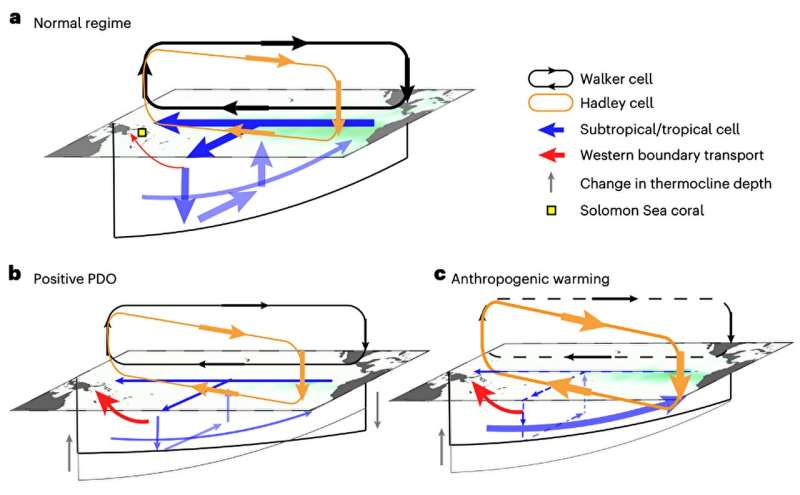Corals reveal 100-year warming history of the Pacific Ocean

Earth’s oceans are a complex system of interconnected transport highways for heat, nutrients and the transfer of carbon dioxide between the atmosphere and sea. Meridional overturning circulation is the process by which these key components move from the tropics poleward to the subtropics. Research has found that an increase in this circulation pattern can be beneficial as it results in the ocean storing more heat and therefore draws down global temperature.
New research published in Nature Geoscience focuses on one particular current, the western boundary current in the Pacific, which is a major component of the Equatorial Undercurrent. Also termed the Cromwell Current, this subsurface current at 200 m depth flows eastwards at a rate of 1.5 m/s across the length of the equator in the Pacific Ocean.
Scientists from the National Taiwan University and their collaborators assessed changes in this current over the last century using coral records of the genus Porites obtained from live organisms in the Solomon Sea. This particular coral preserves two distinct nitrogen isotopes (15N and 14N) and the ratio of these is known to decrease as temperature increases.
In addition to this, the researchers found that the western boundary current had strengthened over this time, leading to a consequent strengthening of the Equatorial Undercurrent. They suggest that a slowdown of global warming during the 1940s and 1970s may be attributed to surface waters cooling in the eastern equatorial Pacific.
The overturning circulation occurring in the upper ocean takes place in subtropical-tropical cells, which are predominantly driven by surface winds. Here, subtropical water subducts in the eastern Pacific Ocean and travels west, as well as towards the equator, in the pycnocline layer, which separates surface water from deep water. Upon entering the Equatorial Undercurrent, the water upwells to the surface at the equator and is driven back to the subtropics by surface winds in the Ekman layer. The Solomon Sea, where this research is based, is a western boundary between the equator and subtropics.
During seasonal El Niño events, these easterly equatorial winds reduce, causing a decline in the strength of the subtropical-tropical cells. However, the subducting waters overcompensate by bringing more water from the subtropics to the equator in the Solomon Sea.

The nitrogen isotopes considered in this study vary in different layers of the ocean of the tropics and subtropics, sourced from nitrates in the upper thermocline layer (down to 400 m water depth) and suspended nitrogen from organic matter in the surface layer (maximum 200 m water depth). High 15N/14N ratios occur close to the equator where there is increased upwelling of cool, nutrient-rich waters into the area. Coupled with this, such zones of upwelling experience issues with biological productivity using all available nutrients, hence nitrate and phosphate concentrates in the surface waters.
These nutrients are transported westward and are used by phytoplankton suspended in the water to thrive. They preferentially absorb the lighter 14N isotope, meaning the heavier 15N is left in the ocean to concentrate further, therefore creating a distinct pattern of increased 15N in surface waters moving from east to west. However, during an El Niño event 15N/14N ratios reduce as there is less upwelling.
Dr. Wen-Hui Chen and their collaborators identified corals using nitrogen to build their structure, obtained from the zooplankton and particulates they feed upon in the ocean. These corals preserved reduced 15N/14N ratios during southern hemisphere winter, when cold saline waters are preferentially transported into the Solomon Sea.
Sea surface temperature is seemingly a major factor affecting the 15N/14N ratios, particularly in relation to a climate pattern known as the Pacific Decadal Oscillation, which occurs every 20 to 30 years. This experiences a warm positive phase with weaker easterly winds, alternating with cool negative phases where these easterly trade winds are stronger.
The researchers found that their 15N/14N ratios from the corals tracked these changes on decadal timescales (with a lag of nine months), with lower values occurring in the Solomon Sea corals during the positive phases.
This corresponds to a longer-term observed trend of declining 15N/14N ratios matching temperature changes due to global warming. The scientists explain this is a consequence of intensified western boundary currents in the Solomon Sea. They do however stress that these currents may actually help to offset the shallowing of the thermocline layer, caused by global warming, by supplying more warm water and enabling the tropical-subtropical systems, as well as El Niño events, to continue.
More information:
Wen-Hui Chen et al, Increased tropical South Pacific western boundary current transport over the past century, Nature Geoscience (2023). DOI: 10.1038/s41561-023-01212-4
© 2023 Science X Network
Citation:
Corals reveal 100-year warming history of the Pacific Ocean (2023, July 27)
retrieved 27 July 2023
from https://phys.org/news/2023-07-corals-reveal-year-history-pacific.html
This document is subject to copyright. Apart from any fair dealing for the purpose of private study or research, no
part may be reproduced without the written permission. The content is provided for information purposes only.
For all the latest Science News Click Here
For the latest news and updates, follow us on Google News.

